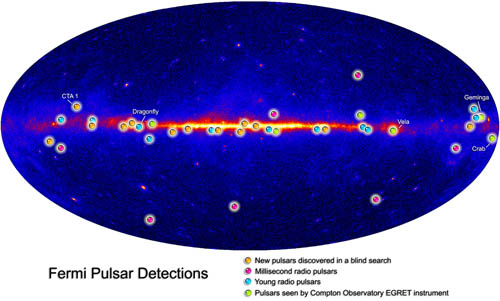Imagine the Universe News - 22 January 2009
NASA'S Fermi Telescope Unveils a Dozen New Pulsars
| 22 January 2009 |
"We know of 1,800 pulsars, but until Fermi we saw only little wisps of energy from all but a handful of them," says Roger Romani of Stanford University, Calif. "Now, for dozens of pulsars, we're seeing the actual power of these machines."
 Click for larger image |
| NASA's Fermi Gamma-ray Space Telescope has found 12 previously unknown pulsars (orange). Fermi also detected gamma-ray emissions from known radio pulsars (magenta, cyan) and from known or suspected gamma-ray pulsars identified by NASA's Compton Gamma-Ray Observatory (green). (Credit: NASA/Fermi/LAT Collaboration) |
| A new class of gamma-ray-only pulsars shows that the gamma rays must form in a broader region than the lighthouse-like radio beam. In this illustration, the pulsar's radio beams (green) never intersect Earth, but its pulsed gamma rays (magenta) do. (Credit: NASA/Fermi/Cruz deWilde) |
A pulsar is a rapidly spinning and highly magnetized neutron star, the crushed core left behind when a massive sun explodes. Most were found through their pulses at radio wavelengths, which are thought to be caused by narrow, lighthouse-like beams emanating from the star's magnetic poles.
If the magnetic poles and the star's spin axis don't align exactly, the spinning pulsar sweeps the beams across the sky. Radio telescopes on Earth detect a signal if one of those beams happens to swing our way. Unfortunately, any census of pulsars is automatically biased because we only see those whose beams sweep past Earth.
"That has colored our understanding of neutron stars for 40 years," Romani says. The radio beams are easy to detect, but they represent only a few parts per million of a pulsar's total power. Its gamma rays, on the other hand, account for 10 percent or more. "For the first time, Fermi is giving us an independent look at what heavy stars do," he adds.
| This video illustrates an earlier idea in which gamma-rays (magenta) arose from the neutron star's magnetic poles, where the radio beam (not shown) originates. The new pulsars Fermi discovered show this cannot be the case. (Credit: NASA/Goddard Space Flight Center Conceptual Image Lab) |
Pulsars are phenomenal cosmic dynamos. Through processes not fully understood, a pulsar's intense electric and magnetic fields and rapid rotation accelerate particles to speeds near that of light. Gamma rays let astronomers glimpse the particle accelerator's heart.
"We used to think the gamma rays emerged near the neutron star's surface from the polar cap, where the radio beams form," says Alice Harding of NASA's Goddard Space Flight Center in Greenbelt, Md. "The new gamma-ray-only pulsars put that idea to rest." She and Romani spoke at the American Astronomical Society meeting in Long Beach, California held earlier this month.
Astronomers now believe the pulsed gamma rays arise far above the neutron star. Particles produce gamma rays as they accelerate along arcs of open magnetic field. For the Vela pulsar, the brightest persistent gamma-ray source in the sky, the emission region is thought to lie about 300 miles from the star, which is only 20 miles across.
Existing models place the gamma-ray emission along the boundary between open and closed magnetic field lines. One version starts at high altitudes; the other implies emission from the star's surface all the way out. "So far, Fermi observations to date cannot distinguish which of these models is correct," Harding says.
| Isolated pulsars gradually slow their spins, but the opposite happens if the pulsar is joined by a companion star as part of a binary system. Gas accreted from the star can force the pulsar to spin faster, resulting in rotation periods of just a few milliseconds. (Credit: NASA/Dana Berry) |
Because rotation powers their emissions, isolated pulsars slow as they age. The 10,000-year-old CTA 1 pulsar, which the Fermi team announced in October, slows by about a second every 87,000 years.
Fermi also picked up pulsed gamma rays from seven millisecond pulsars, so called because they spin between 100 and 1,000 times a second. Far older than pulsars like Vela and CTA 1, these seemingly paradoxical objects get to break the rules by residing in binary systems containing a normal star. Stellar matter accreted from the companion can spin up the pulsar until its surface moves at an appreciable fraction of light speed.
NASA's Fermi Gamma-ray Space Telescope is an astrophysics and particle physics partnership, developed in collaboration with the U.S. Department of Energy, along with important contributions from academic institutions and partners in France, Germany, Italy, Japan, Sweden, and the U.S.

